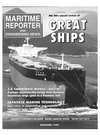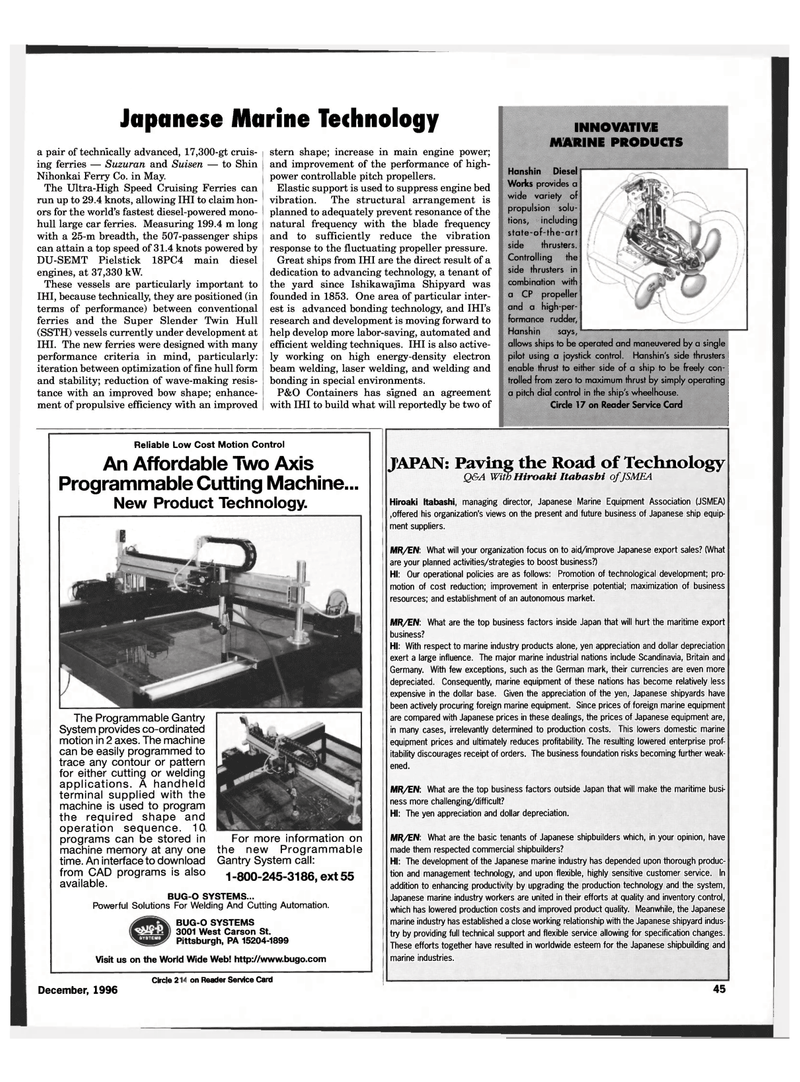
Page 43: of Maritime Reporter Magazine (December 1996)
Read this page in Pdf, Flash or Html5 edition of December 1996 Maritime Reporter Magazine
Japanese Marine Technology a pair of technically advanced, 17,300-gt cruis- ing ferries — Suzuran and Suisen — to Shin
Nihonkai Ferry Co. in May.
The Ultra-High Speed Cruising Ferries can run up to 29.4 knots, allowing IHI to claim hon- ors for the world's fastest diesel-powered mono- hull large car ferries. Measuring 199.4 m long with a 25-m breadth, the 507-passenger ships can attain a top speed of 31.4 knots powered by
DU-SEMT Pielstick 18PC4 main diesel engines, at 37,330 kW.
These vessels are particularly important to
IHI, because technically, they are positioned (in terms of performance) between conventional ferries and the Super Slender Twin Hull (SSTH) vessels currently under development at
IHI. The new ferries were designed with many performance criteria in mind, particularly: iteration between optimization of fine hull form and stability; reduction of wave-making resis- tance with an improved bow shape; enhance- ment of propulsive efficiency with an improved stern shape; increase in main engine power; and improvement of the performance of high- power controllable pitch propellers.
Elastic support is used to suppress engine bed vibration. The structural arrangement is planned to adequately prevent resonance of the natural frequency with the blade frequency and to sufficiently reduce the vibration response to the fluctuating propeller pressure.
Great ships from IHI are the direct result of a dedication to advancing technology, a tenant of the yard since Ishikawajima Shipyard was founded in 1853. One area of particular inter- est is advanced bonding technology, and IHI's research and development is moving forward to help develop more labor-saving, automated and efficient welding techniques. IHI is also active- ly working on high energy-density electron beam welding, laser welding, and welding and bonding in special environments.
P&O Containers has signed an agreement with IHI to build what will reportedly be two of
INNOVATIVE
MARINE PRODUCTS
Hanshin Diesel
Works provides a wide variety of propulsion solu- tions, including state-of-the-art side thrusters.
Controlling the side thrusters in combination with a CP propeller and a high-per- formance rudder,
Hanshin says, allows ships to be operated and maneuvered by a single pilot using a joystick control. Hanshin's side thrusters enable thrust to either side of a ship to be freely con- trolled from zero to maximum thrust by simply operating a pitch dial control in the ship's wheelhouse.
Circle 17 on Reader Service Card
Reliable Low Cost Motion Control
An Affordable Two Axis
Programmable Cutting Machine...
New Product Technology.
BUG-O SYSTEMS...
Powerful Solutions For Welding And Cutting Automation.
BUG-0 SYSTEMS 3001 West Carson St.
Pittsburgh, PA 15204-1899
Visit us on the World Wide Web! http://www.bugo.com
The Programmable Gantry
System provides co-ordinated motion in 2 axes. The machine can be easily programmed to trace any contour or pattern for either cutting or welding applications. A handheld terminal supplied with the machine is used to program the required shape and operation sequence. 1(X programs can be stored in machine memory at any one time. An interface to download from CAD programs is also available.
For more information on the new Programmable
Gantry System call: 1-800-245-3186, ext55
JAPAN: Paving the Road of Technology
Q&A WithHiroaki It abas hi ofJSMEA
Hiroaki Itabashi, managing director, Japanese Marine Equipment Association (JSMEA) .offered his organization's views on the present and future business of Japanese ship equip- ment suppliers.
MR/EN: What will your organization focus on to aid/improve Japanese export sales? (What are your planned activities/strategies to boost business?)
HI: Our operational policies are as follows: Promotion of technological development; pro- motion of cost reduction; improvement in enterprise potential; maximization of business resources; and establishment of an autonomous market.
MR/EN: What are the top business factors inside Japan that will hurt the maritime export business?
HI: With respect to marine industry products alone, yen appreciation and dollar depreciation exert a large influence. The major marine industrial nations include Scandinavia, Britain and
Germany. With few exceptions, such as the German mark, their currencies are even more depreciated. Consequently, marine equipment of these nations has become relatively less expensive in the dollar base. Given the appreciation of the yen, Japanese shipyards have been actively procuring foreign marine equipment. Since prices of foreign marine equipment are compared with Japanese prices in these dealings, the prices of Japanese equipment are, in many cases, irrelevantly determined to production costs. This lowers domestic marine equipment prices and ultimately reduces profitability. The resulting lowered enterprise prof- itability discourages receipt of orders. The business foundation risks becoming further weak- ened.
MR/EN: What are the top business factors outside Japan that will make the maritime busi- ness more challenging/difficult?
HI: The yen appreciation and dollar depreciation.
MR/EN: What are the basic tenants of Japanese shipbuilders which, in your opinion, have made them respected commercial shipbuilders?
HI: The development of the Japanese marine industry has depended upon thorough produc- tion and management technology, and upon flexible, highly sensitive customer service. In addition to enhancing productivity by upgrading the production technology and the system,
Japanese marine industry workers are united in their efforts at quality and inventory control, which has lowered production costs and improved product quality. Meanwhile, the Japanese marine industry has established a close working relationship with the Japanese shipyard indus- try by providing full technical support and flexible service allowing for specification changes.
These efforts together have resulted in worldwide esteem for the Japanese shipbuilding and marine industries.
Circle 287 on Reader Service Card
December, 1996 45

 42
42

 44
44
